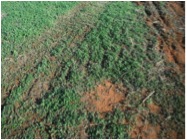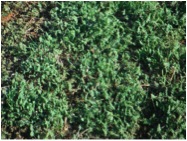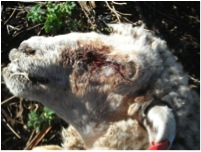
CASE NOTES
CRYSTAL ASSOCIATED CHOLANGIOPATHY (YELLOW BIG HEAD) IN LAMBS GRAZING TRIBULUS TERRESTRIS
Greg McCann (Central West LHPA, Dubbo)
Posted Flock & Herd July 2013
History
A mob of 340 6-8mo cross bred lambs were grazed on a canola stubble paddock in the Yeoval area in February after receiving 50mm of rain some 6 weeks previously. The mob was also offered barley grain as a supplement run out on the ground. Two days after introduction, a couple of lambs were noted as hanging back and not coming onto the feed. The following day the mob was examined by the owner at a closer distance and major problems were observed. Initial contact with the LHPA was via phone. A diagnosis of secondary photosensitization was made based on reported signs and the farmer was advised to remove the lambs from the current paddock and put them in a paddock with good shade and water. Two days later the farmer sought a property visit because the losses were becoming substantial in spite of the paddock shift.


Figure 1, 2 Prolific growth of Tribulus terrestris
Clinical findings
In quite a few of the lambs, there was gross swelling around the head with drooping ears and swelling around the muzzle. Some of the eyes were nearly completely shut due to swelling. There appeared to be a yellowy discharge from the eyes.
At this point, there had been approximately 70 deaths in the mob, with a further 30 or so showing severe photosensitization. A paddock inspection of the canola stubble revealed a substantial coverage of short green cathead (Tribulus terrestris) and little else. Affected skin was erythematous and there was marked fluid swelling under the skin, with seepage of clear or yellow fluid through the inflamed skin, leading to swollen droopy ears, swollen lips and eyelids and swelling of the entire head, with a raw weeping muzzle. Chronic cases developed skin necrosis, with ear tips curling up and lips becoming immobilised. Most of these died in spite of antibiotic and anti-inflammatory therapy.


Figures 3, 4. Chronically affected sheep
Discussion
The toxic principle involved is a steroidal saponin that accumulate in the leaves and stems of T. terrestris. Plants under stress are most likely to be toxic, with young animals most severely affected. Susceptible skin sites include ears, eyelids, face, lips and around the top of hooves.
The losses from the acute episode reached approximately 100 deaths. Although the milder cases recovered, the producer was warned about potentially poor growth rates in some lambs due to chronic liver damage.